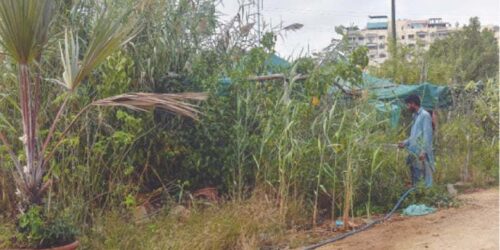KARACHI: No plantation campaign can increase green cover of the city unless the government enacts a Karachi-specific law for tree protection and plantation and imposes a strict ban on cutting of tree/s, unless it is authorised by an expert committee representing all stakeholders, including the academia. This body should also serve as a legal authority on granting permission for tree plantation at public spaces.
This was shared by experts in a conversation with Dawn on Sunday.
They were expressing their opinion about the recently launched tree plantation campaigns in terms of their significance in improving green cover of Karachi.
Ad-hoc and non-scientific approaches never bring out positive, sustainable outcomes. Plantation at public spaces should follow thorough planning, which means studying land and soil properties and getting details about the civic infrastructure existing above and under the ground at the site,” said Dr Zafar Iqbal Shams, a senior teacher and researcher at Karachi University’s Institute of Environmental Studies.
In other words, the job required involvement of relevant stakeholders, including the community that could play an important role in ensuring sustainability of plantation, he added.
“If these factors are ignored, saplings will either die soon out or suffer from stunted growth, wasting money, time and energy while contributing nothing to environmental improvement.”
No law to protect trees
Asked about Karachi’s green cover, Prof Jamil Kazmi of KU’s geography department who has studied the subject extensively through Geographic Information System (GIS) mapping, said that the city’s green cover increased from 500 square kilometres in 1998 to 570 square km in 2008 due to extensive plantation of conocarpus and mangroves and expansion of the agriculture sector.
“It was reduced to 260 square km in 2018 and 2019 (within the city), almost a 50 per cent reduction, following reduction in groundwater level, depletion of agricultural area due to extensive extraction of sand and gravel along riverbeds that led increased runoff, desertification and urban flooding. Another factor contributing to reduction in tree cover was the increase in the built-up area.”
Exotic species
The city’s green cover, he argued, could only increase with eco-friendly development and trees were protected under a legal cover.
“Thousands of trees are cut down on account of different development projects and a few hundred saplings are planted as replacement. On the other hand, we see either plantation of exotic species or ones which are not suitable for a particular land and the result is high mortality.”
In this respect, Dr Kazmi referred to plantation of date palm trees on the University Road by the government sometime back. Ninety per cent of them died. Each plant costing about Rs2,500 had been brought from Khairpur.
“There is a need for a scientific approach in consultation with experts. We must discourage monoculture as it happened in the past and the entire city was filled with eucalyptus and then conocarpus and promote indigenous species.”
Highlighting some other challenges to increasing the city’s cover, senior ecologist Rafi-ul-Haq said the biggest challenge was the absence of a single civic authority governing the whole city and a Karachi-specific law for tree protection and plantation.
“The forest law doesn’t apply to Karachi. We need a law that clearly defines rules and regulations for plantation in the city and fixes severe punishment on tree cutting. There should be an expert body with legal powers to survey the city and develop plantation guidelines for a particular area per its requirements, permits plantation campaigns and monitor the process periodically.”
Three city zones
According to experts, the city can be divided into water-logged, saline and dry land zones and plants suitable to specific conditions should be grown in a specific area. Apart from the coastal land, many parts of the city have become water-logged and highly saline due to leaking water and sewerage pipes.
Plants, such as conocarpus and eucalyptus, Dr Shams suggest, can help improve soil conditions in these areas, if they are planted with proper planning and care. They both are exotic non-invasive (not a threat to local vegetation) with high water requirements and deep roots that can damage underground civic infrastructure.
Ecological trial
All exotic/imported species must go through an ecological trial to prove that they are not invasive, he said.
Plants suitable for water-logged and saline land also include coconuts, chikoo, babul or gum, Jerusalem thorn, Farash, java palm (jamun) and sugar apple (sharifa).
Both date and coconut species are members of the palm family. The former is suitable for dry areas and the other for coastal land.
“Plants such as moringa, date palm and wild almonds are not suitable for coastal land and will show poor growth,” replied Dr Mohammad Qaiser, senior botanist and co-author of Flora of Pakistan, when asked about plantation of these species under a recently launched urban forest project along the Clifton beach.
An exotic species, he pointed out, didn’t necessarily be invasive (species) that threaten local biodiversity as they fast replace local vegetation.
“Devi or vilayati keekar (Prosopis julifora) that releases toxins tops the list of invasive species in our environment as it has spread across the country. Leucaena leucocephala (ipil ipil), which is among the 100 worst invasive species in the world, can be seen in some areas of Karachi.”
Some exotic species suggested by Dr Shams for different districts of Karachi are: Delonix regia (Gulmohr), Pithecellobium dulce (Jungal jalebi), Peltophorum pterocarpum (Copper pod), Parkinsonia aculeata (Jelly bean tree) and Cordia sebestena (Geiger tree).
Some suggested native tree species: Crateva adansonii (Barna), Alstonia scholaris (Devil tree), Albizia julibrissin (pink siris), Albizia lebbeck (lebbek tree), Cassia fistula (Amaltas), Erythrina suberosa (Flame tree), Thespesia populnea (Portia tree), Dalbergia sisso (Sheesham) and Monoon longifolium (false ashoka) and Moringa oleifera.





